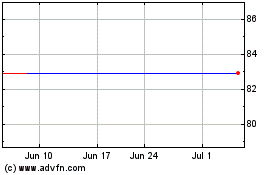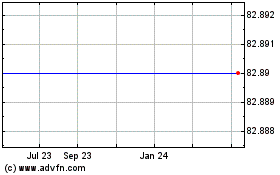Randgold Net Profit Falls; Eyes Dividend Boost --2nd Update
August 04 2016 - 12:20PM
Dow Jones News
By Alex MacDonald
LONDON--Randgold Resources Ltd. (GOLD) suffered production
setbacks at its two mines in the Ivory Coast and Congo that
resulted in a 8.5% drop in second quarter net profit.
But the FTSE 100 miner vowed to still meet its full-year
production and cost guidance, and also reaffirmed willingness to
revise its dividend policy with a view to returning a significant
portion of future cash flow to shareholders.
Randgold's net profit fell to $49 million in the three months
ended June 30, compared with $54 million in the same period a year
earlier, following a 3.6% drop in revenue to $277 million during
the period. Revenue dropped due to a 3.6% fall in gold output to
281,494 troy ounces, which more than offset a 6.3% rise in the
average gold selling price.
Randgold's shares closed down 3.8% on the day at 8,635 pence a
share after falling nearly 12% earlier in the day.
Analysts said the results were disappointing due to the severity
of the setbacks at Randgold's Tongon mine in the Ivory Coast and
the Kibali mine in the Congo. Shares however, pared back their
losses in afternoon trading after the Bank of England lowered its
key interest rate, causing the spot gold price to swing into
positive territory. Numis Securities analyst Justin Chan said
Randgold's investor call also reminded that the company's
"fundamentals remain strong...in fact the second half should be
quite strong, as management has guided."
Chief Executive Mark Bristow conceded that the second quarter
was "without doubt one of the tougher operating quarters we
had."
The West African gold producer suffered 46 days of lost Tongon
output due to longer-than-expected plant repairs, Mr. Bristow said.
Also Kibali faced challenges from processing multiple ore feeds
while trialing new equipment that led to lower throughput, recovery
and grade dilution, he noted. The problems resulted in a 6.3%
on-year rise in cash costs to $727/oz in the second quarter.
Nevertheless, the company still generated net cashflow from
operations of $101.5 million in the second quarter, up 42% from the
same period a year earlier due to lower working capital. This more
than doubled the company's net cash position to $273 million as of
June-end. Mr. Bristow reaffirmed the company wants to maintain a
$500 million cashpile to build a new mine without having to raise a
lot of debt.
Once "we get to half a billion [dollar] level... we will try to
convince the board to change" the company's dividend policy with a
view to returning a greater portion of the cashflow to
shareholders, he said. Randgold should hit the net cash target by
year-end and $1 billion at the end of 2017 if gold stays above
$1,350/oz, he said.
He also dismissed the likelihood of big acquisitions, including
any interest in making an offer for rival Acacia Mining PLC
(ACA.LN), Tanzania's largest gold miner. Barrick Gold Corp. (ABX),
Acacia's parent company "would certainly be happy. My shareholders
wouldn't," he said, noting that Acacia Mining was fully-valued.
The company reaffirmed its target to produce between 1.25
million to 1.3 million gold ounces this year at a cash cost of
between $590/oz to $630/oz. Lost output from the Tongon mine should
be offset by better-than-expected performance from its
Loulo-Gounkoto mining complex in Mali, while a new satellite
deposit at Kibali should feed higher grade ore into the mine's
plant, thereby allowing the mine to reach its annual target, Mr.
Bristow said.
-Write to Alex MacDonald at alex.macdonald@wsj.com
(END) Dow Jones Newswires
August 04, 2016 12:05 ET (16:05 GMT)
Copyright (c) 2016 Dow Jones & Company, Inc.
Randgold Resources Limited ADS Each Represented BY One Ordinary Share (delisted) (NASDAQ:GOLD)
Historical Stock Chart
From Mar 2024 to Apr 2024

Randgold Resources Limited ADS Each Represented BY One Ordinary Share (delisted) (NASDAQ:GOLD)
Historical Stock Chart
From Apr 2023 to Apr 2024
